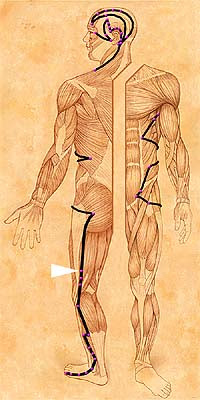
I'm not going to try to make a moral judgement case out of this, I think most of us agree various forms of "torture" are abhorrent.
Everyone is aware that "Waterboarding" and other forms of "enhanced interrogation" have been used in the Iraq and Afghan wars. But seldom mentioned are the use of pressure-points to control detainees. Two cases stand out:
"A CIA inspector general’s report written in 2004 was released in a less-redacted version Monday, revealing new details of the agency’s torture techniques applied to terror war prisoners.
Page 77 of the report discusses “unauthorized or undocumented techniques” used by CIA agents but not approved by the Bush administration’s Department of Justice. One such “improvised action” was a pressure point tactic: the compression of a detainee’s carotid artery by an agent with both hands around the prisoner’s neck.
Prolonged compression of the carotid artery is lethal, as it cuts off blood flow to the brain".
(Link)

The above picture is the Stomach Meridian, with the white arrow pointing to st-9. From the discription of the incident, it sounds to me like the interrogator was pulsing the point off and on, causing repeated blackouts. This was not simply a guy choking his hand around the neck, it was clinical in application.
Most martial artists are aware of "The Blood Choke", commonly applied with a forearm barred across the side of the neck. St-9 can also be activated with a chop or finger-jab to the exact point, cutting off blood flow, causing the person to "pass out".
This is far more dangerous than it might sound, it could conceivably cause a stroke or death.

The other pressure-point story that stands out is the use of repeated knee-strikes to the outside of the thigh. This pressure-point is Gallbladder meridian-31.
Gb-31 is at the charley-horse point on the thigh, you can feel it on your own leg. I would rather take a full-on kick to the ribs than take a piercing knee-strike to this vulnerable point. Here's an example of the horrible way it was used:
Example 1.
"By Dec. 3, Habibullah's reputation for defiance seemed to make him an open target. One guard said he had given him five peroneal strikes for being "noncompliant and combative." Another gave him three or four more for being "combative and noncompliant." Some guards later asserted that he had been hurt trying to escape.
When Sergeant James Boland saw Habibullah on Dec. 3, the prisoner was in one of the isolation cells, tethered to the ceiling by two sets of handcuffs and a chain around his waist. His body was slumped forward, held up by the chains.
When Boland returned to the cell about 20 minutes later, he said, Habibullah was not moving and had no pulse.
Finally, the prisoner was unchained and laid out on the floor of his cell.
Habibullah died on Dec. 3. His autopsy showed bruises or scrapes on his chest, arms, head and neck. There were deep bruises on his calves, knees and thighs. His left calf had been marked by what appeared to have been the sole of a boot.
His death was attributed to a blood clot, probably caused by the severe injuries to his legs, which traveled to his heart and blocked the blood flow to his lungs.
Note: "Peroneal", Of, relating to, or located near the fibula.
Example 2.
"Dilawar was sent to Bagram and soon labeled "noncompliant." One of the guards, Specialist Corey Jones, said the prisoner spat in his face and started kicking him. Jones responded, he said, with a couple of knee strikes to the leg of the shackled man.
"He screamed out, 'Allah! Allah! Allah!' and my first reaction was that he was crying out to his god," Jones said to investigators. "Everybody heard him cry out and thought it was funny."
"It became a kind of running joke, and people kept showing up to give this detainee a common peroneal strike just to hear him scream out 'Allah,"' he said. "It went on over a 24-hour period, and I would think that it was over 100 strikes."
By the time Dilawar was brought in for his final interrogation in the first hours of Dec. 10, he appeared exhausted and was babbling that his wife had died. He also told the interrogators that he had been beaten by the guards.
When Dilawar was unable to kneel, said the interpreter, Ali Baryalai, the interrogators pulled him to his feet and pushed him against the wall.
"It looked to me like Dilawar was trying to cooperate, but he couldn't physically perform the tasks," Baryalai said.
Soon afterward he was dead".
(D.R.) -For the record, Dilawar was a taxi driver, the subject of the movie "Taxi To The Dark Side". Here's what happened:
"In February, a U.S. military official disclosed that the Afghan guerrilla commander whose men had arrested Dilawar and his passengers had been detained. The commander was suspected of attacking Camp Salerno and then turning over innocent "suspects" to the Americans in a ploy to win their trust, the military official said.
The three passengers in Dilawar's taxi were sent home from Guantánamo in March 2004, 15 months after their capture, with letters saying they posed "no threat" to American forces".
(Link)












No comments:
Post a Comment